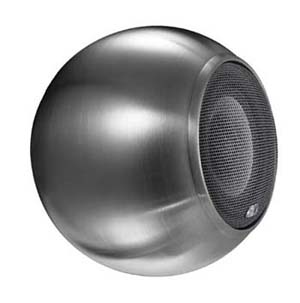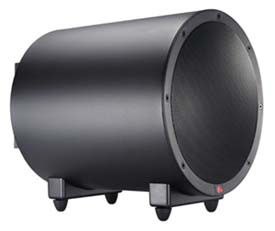Introduction
In a little more than a decade, Anthony Gallo Acoustics has developed a
reputation for high-quality, high value speaker systems. It has also earned
a reputation for its unusual design, with speakers that look more like
tennis balls than "conventional" speakers.
The A'Diva Tis represent the
latest addition to the Gallo product line, and bring to mind the old adage
about good things coming in small packages.
The Design
Anthony Gallo was definitely thinking "outside of the box" when designing
the foundation of the A'Diva (and before that, Micro) speaker ranges. The
satellite speaker is a five-inch metal sphere, containing a single
three-inch titanium full-range (highs and mids) driver.
The spheroid design is the product of
function over fashion. According to Gallo, the spherical shape reduces
standing waves inherent in box-like cabinet designs, and has no external
baffle diffraction to smear the signal. Gallo also claims that because of
the inherent strength of the sphere (it's why chicken eggs are ellipsoid
rather than shaped
like boxes), it provides a lightweight stable cabinet without need of
internal bracing.
This design approach carries over to the TR-2 subwoofer, a cylindrical steel
tube containing a long-throw, 10" front-firing woofer mated to an internal
250 watt Class A/B amplifier. The back panel of the TR-2 has the usual
controls, including variable low-pass filter (from 50 to 180 Hz), line and
speaker level inputs, continuously variable phase, and automatic standby.
The subwoofer also has a fixed, three-way toggle equalizer that adds +3 or
+6 dB boost when engaged. The TR-2 is quite small for a subwoofer, standing a
scant 12 inches high and less than 11 inches wide, but will give you a
surprise when you try to lift it out of the box. The enclosure is solid
steel (no MDF), and weighs a hefty 36 pounds. Gallo also offers a smaller,
100 watt subwoofer, the TR-1.
The other unique aspect of the A'Diva Tis, even in a satellite system, is
the use of a single driver in the main speaker. The three-inch titanium
driver covers the entire frequency range above THX crossover (80 Hz), thus
eliminating the need for an internal crossover.
Gallo claims that there is
no such thing as a good crossover, since they introduce time and phase
distortion that degrade the original signal (note however, that the natural
roll-off of a driver does produce phase shift on its own, even without a
crossover in the circuit).
Of course, my clock-radio also
uses a single driver without a crossover, but no one would confuse it with
audiophile quality sound. So, leaving the engineering debates to the online
forums, the real question, is how does it sound?
 The
Set-up
The
Set-up
The A'Diva Ti system (as reviewed) consists of five identical satellite
speakers, plus the TR-2 subwoofer. The satellite speakers each come with a
rubber O-ring, for mounting on a bookshelf, table, or TV. Gallo also sells
custom stands, four of which were supplied for the review. The center
channel speaker was placed on the O-ring atop my RPTV, while the other four
speakers were mounted on the 37" stands. The speakers attach to the stands
using a ball-and-socket joint, which conveniently allowed me to tilt the
side-surround speakers so that they pointed above and behind the seating
position, simulating the more conventional above-the-head, side-wall
location.
The A'Diva Ti stands allow for speaker wire to be threaded up the interior of
the metal shaft. However, the combination of the curved vertical column,
along with a rather tight clearance on the binding posts, dictated using
relatively thin 14-gauge speaker wire. In fact, Gallo sells 18-gauge solid
core speaker wire as an available accessory. Although the A'Diva Tis had
binding posts capable of accepting spades or banana plugs, the tight spacing
made using bare wire the preferred connection method.
The TR-2 was placed in my usual subwoofer location, the front right corner
of the listening room, where it also benefited from room loading. The
owner's manual suggests setting your receiver/processor crossover between 80
and 120 Hz, although Gallo prefers the THX standard 80 Hz setting. During the
review period, I alternated between the 80 Hz setting, and allowing my
receiver's automatic calibration software to custom-set each speaker's
crossover setting to account for room acoustics.
Fit and finish were excellent on the speakers, the brushed metal conveying
strength and heft. Although the review samples were matte black, Gallo also
sells the A'Diva Tis in matte white, silver-gray, and stainless steel (Gallo's
Nucleus Micro speakers are available in a virtual rainbow of designer
colors). The A'Diva Tis retail for $275 each ($300 for stainless steel),
and the TR-2 subwoofer lists at $700. However, you can purchase the complete
system (five A'Diva Tis and a TR-2) for $1,975.
The style of the A'Diva Tis, especially on the supplied stands, are a matter
of subjective taste. Personally, I loved the futuristic look, although
several visitors thought they were accent lights. Their confusion was
short-lived, however, once I fired up the system. The fact that they look
like accent lights could be a plus in terms of spouse acceptance factor,
since they just blend into the room that way.
 The
Sound
The
Sound
I initially mated the Gallos with Onkyo's entry-level receiver, the
TX-SR502 (since Onkyo is known for its high-quality, high-value receivers, I
thought they would make a good match).
No one should expect a small
satellite system, especially with only one driver per speaker, to reproduce
sound that rivals full-range speakers. So with my expectations set
accordingly, I ran through a selection of hi-rez multi-channel discs.
Usually, it takes a while to get used to the feel of a particular system
before critical listening is worthwhile. However, it was apparent from the
get-go that the Gallo's were something special. First up was the opening
track from Elton John’s Goodbye Yellow Brick Road (SACD), "Funeral For A
Friend-Love Lies Bleeding". The A'Diva Ti's disappeared, leaving an enormous
soundstage that enveloped the listener. I simply could not believe the level
of imaging, of resolving individual instruments, that was possible with only
five drivers (plus the subwoofer).
Determined to see what the A'Diva Tis were capable of, I replaced the modest
Onkyo receiver with Integra's new DTR 7.6 receiver (review forthcoming). Not
surprisingly, it was like the proverbial lifting of the veil. "Heart of the
Sunrise", from Yes’ Fragile (DVD-A), contains multiple guitar tracks,
electric bass, and keyboards flying in ascending and descending counterpart
scales. On lesser systems, the track can turn into indistinguishable mush,
but with the Gallo/Integra combination I could distinctly hear each Steve
Howe guitar riff.
Even on Redbook CDs, the A'Diva Tis were capable of amazing
detail. I sat through the entire Rubber Soul album (if you need to ask by
whom, don’t bother), admiring Ringo's flourishes on the tambourine. During
the review period, Gallo's PR firm mentioned that the A'Diva Tis had just been
used to mix Stevie Wonder's new album, and I'm not surprised. The Gallos
have the transparency that one would expect from studio monitors.
Switching to movies, Mel Gibson's We Were Soldiers is like watching the
Omaha Beach scene from Saving Private Ryan, except that it lasts twice as
long. The Gallos put me right into the middle of the battlefield,
with tracer rounds flying overhead and the sounds of the M-16s and AK-47s
distinct. The TR-2 subwoofer convincingly reproduced the whoomp of artillery
shells, although the limits of the smaller enclosure became apparent when
pushed to extremes in my larger-than-average listening space.
In fact, the only downside (if that's even a fair term) of the Gallos is the
recognition that, in larger spaces and higher decibels, you can only move so
much air with a three-inch driver. But if you’re looking to fill a large
space with wall-shaking sound, you should not be auditioning small satellite/sub
systems in any event. Remember, these speakers are designed not to overpower
a room with big boxes, but to still deliver quality sound even though they
are diminutive.
Conclusions
There are several ways to evaluate the Gallo A'Diva Ti system. Judged solely
on the basis of a micro-satellite system, the A'Diva Tis wildly exceed
expectations. On a pure bang-for-the-buck basis, $1,975 buys you an
audiophile system for a fraction of the price typically charged for
full-range floor-standing systems of similar quality. Will the A'Diva Tis
totally eliminate the need for those full-range speakers? In larger spaces,
the answer is no. But if you are looking for an integrated system to suit a
moderately sized room, you will definitely want to audition the A'Diva Tis.
Highly recommended!
- Ross Jones -